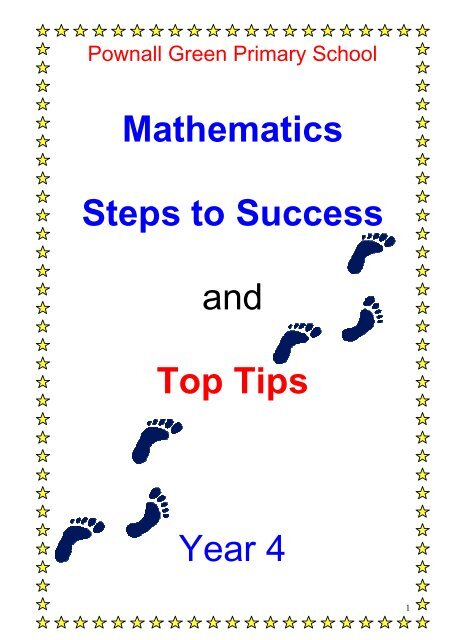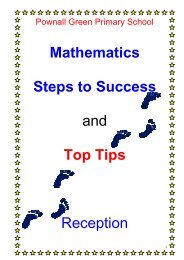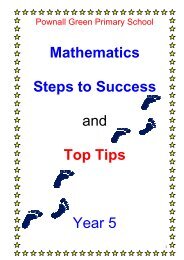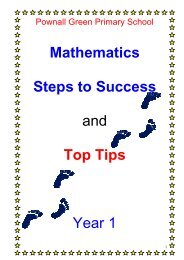Steps to Success and Top Tips - Pownall Green Primary School
Steps to Success and Top Tips - Pownall Green Primary School
Steps to Success and Top Tips - Pownall Green Primary School
You also want an ePaper? Increase the reach of your titles
YUMPU automatically turns print PDFs into web optimized ePapers that Google loves.
<strong>Pownall</strong> <strong>Green</strong> <strong>Primary</strong> <strong>School</strong><br />
Mathematics<br />
<strong>Steps</strong> <strong>to</strong> <strong>Success</strong><br />
<strong>and</strong><br />
<strong>Top</strong> <strong>Tips</strong><br />
Year 4<br />
1
Contents Page<br />
1. To use less than (), equals (=) 3<br />
2. Round numbers less than 1000 <strong>to</strong> the nearest 10 or 100 3<br />
3. Read fractions where the numera<strong>to</strong>r is greater than one 3<br />
4. Read mixed numbers 4<br />
5. Underst<strong>and</strong> equivalent fractions 4<br />
6. Add any pair of two-digit numbers, mentally 4<br />
7. Subtract any pair of two-digit numbers, mentally 4<br />
8. Column addition of two numbers less than 1000 5<br />
9. Column subtraction of two numbers less than 1000 6<br />
10. To know the 2, 5 <strong>and</strong> 10 multiplication tables 6<br />
11. Know the 3 <strong>and</strong> 4 multiplication tables 7<br />
12. Know the 6 <strong>and</strong> 7 multiplication tables 7<br />
13. Know the 8 <strong>and</strong> 9 multiplication tables 7<br />
14. Know the 11 <strong>and</strong> 12 multiplication tables 7<br />
15. Work out division facts <strong>to</strong> multiplication tables 7<br />
16. Find remainders after division 8<br />
17. Units of length, mass <strong>and</strong> capacity 8<br />
18. Use the correct operations <strong>to</strong> word solve problems 9<br />
19. To name polygons 10<br />
20. Say whether a polygon is regular or irregular 10<br />
21. Classify 2-D shapes 10<br />
22. Units of time 10<br />
23. Draw <strong>and</strong> answer questions about bar charts 11<br />
24. Convert cm <strong>to</strong> metres 11<br />
2
<strong>Steps</strong> <strong>to</strong> <strong>Success</strong> <strong>and</strong> <strong>Top</strong> <strong>Tips</strong>– Year 4<br />
Key Learning Objectives<br />
1. To use less than (), equals (=)<br />
<strong>Top</strong> <strong>Tips</strong><br />
• Think of the symbol as a crocodile’s mouth<br />
• The crocodile is greedy <strong>and</strong> his mouth always opens <strong>to</strong> the larger<br />
number<br />
• The less than sign is a squashed L (L for less than)<br />
2. To round numbers less than 1000 <strong>to</strong> the nearest 10 or 100<br />
<strong>Steps</strong> <strong>to</strong> <strong>Success</strong><br />
Rounding <strong>to</strong> 10<br />
1) Which two multiples of 10 is the number in between?<br />
2) Choose which multiple of ten it is nearest <strong>to</strong>. If the unit is 5 or more<br />
then round up.<br />
Rounding <strong>to</strong> 100<br />
1) Which two multiples of 100 is the number in between?<br />
2) Choose which multiple of 100 it is nearest <strong>to</strong>. If the digit in the tens is<br />
5 or more then round up.<br />
Memorise this poem:<br />
Find your digit (the one in the column you are rounding <strong>to</strong>)<br />
Look right next door.<br />
4 or less just ignore.<br />
5 or more, add 1 more.<br />
<strong>Top</strong> <strong>Tips</strong><br />
• If the number is exactly in the middle, then round it up<br />
• Remember ‘High Five’ – the number rounds up<br />
3. To read fractions where the numera<strong>to</strong>r is greater than one<br />
<strong>Top</strong> <strong>Tips</strong><br />
• Remember Denomina<strong>to</strong>r - Down (at the bot<strong>to</strong>m)<br />
• Denomina<strong>to</strong>r = how many equal parts a whole is divided in<strong>to</strong><br />
• Numera<strong>to</strong>r = how many of the equal parts of the whole there are<br />
3
4. To read mixed numbers e.g. 1 ¼<br />
<strong>Top</strong> <strong>Tips</strong><br />
• This is the same as reading whole numbers <strong>and</strong> fractions <strong>to</strong>gether<br />
e.g. 1 ½ is the same as 1 whole <strong>and</strong> a ½<br />
5. To underst<strong>and</strong> the equivalence of simple fractions<br />
<strong>Top</strong> <strong>Tips</strong><br />
• Equivalent fractions may look different, but are really THE SAME<br />
• Use a fraction wall/<strong>to</strong>wer or pizzas/ cakes <strong>to</strong> demonstrate<br />
6. To add any pair of two-digit numbers, mentally<br />
<strong>Steps</strong> <strong>to</strong> <strong>Success</strong><br />
1) Add the tens digits <strong>to</strong>gether<br />
2) Add the units <strong>to</strong>gether<br />
3) Add both answers <strong>to</strong> find the <strong>to</strong>tal<br />
7. To subtract any pair of two-digit numbers, mentally<br />
<strong>Steps</strong> <strong>to</strong> <strong>Success</strong> - Partitioning<br />
1. Put the greater number in your head<br />
2. Partition the smaller number in<strong>to</strong> tens (T) <strong>and</strong> units (U)<br />
3. Either take away the tens or the units first, whichever is easier<br />
<strong>Top</strong> <strong>Tips</strong> – partitioning<br />
• Partitioning is best when the digits of smaller number are smaller than<br />
the corresponding digits of the larger number.<br />
<strong>Steps</strong> <strong>to</strong> <strong>Success</strong> - Compensation (rounding <strong>and</strong> adjusting)<br />
1. Look at the numbers. Can any be rounded <strong>to</strong> the nearest 10?<br />
2. Carry out the simpler calculation.<br />
3. Adjust answer allowing for original rounding.<br />
<strong>Top</strong> <strong>Tips</strong> – compensation<br />
• Compensation is best when the smallest number CAN be rounded up.<br />
<strong>Steps</strong> <strong>to</strong> <strong>Success</strong> - Counting on<br />
1. Put the smaller number in your head<br />
2. Count on <strong>to</strong> the next ten<br />
3. Count up in tens, then in units<br />
4
8. To carry out column addition of two numbers less than 1000<br />
<strong>Steps</strong> <strong>to</strong> <strong>Success</strong><br />
1. Write each digit in the correct place value column<br />
2. Start with the units column <strong>and</strong> add up all the numbers in that<br />
column.<br />
3. If one of the columns adds up <strong>to</strong> an answer of 10 or more:<br />
a. put the units of the answer in the column being added<br />
b. carry the tens digit <strong>to</strong> the next column on the left under the<br />
bot<strong>to</strong>m line.<br />
4. Remember <strong>to</strong> add in the digit you ‘carried ‘ with the next column.<br />
5. Repeat with all the columns<br />
<strong>Top</strong> <strong>Tips</strong><br />
Th H T U<br />
7 6 2<br />
+ 4 5 3<br />
-------------------------------<br />
1 2 1 5<br />
-------------------------------<br />
1 1<br />
• Write the column headings <strong>to</strong> help you.<br />
5
9. To carry out column subtraction of two numbers less than 1000<br />
<strong>Steps</strong> <strong>to</strong> <strong>Success</strong><br />
1. Write the greatest number on <strong>to</strong>p, line up the digits in the place value<br />
columns.<br />
2. Start by subtracting the units column, taking the bot<strong>to</strong>m number away<br />
from the <strong>to</strong>p.<br />
3. If the <strong>to</strong>p digit is less than the digit you are going <strong>to</strong> subtract, you<br />
need <strong>to</strong> exchange with a digit in the column <strong>to</strong> the left. Make the left<br />
neighbour 1 less, write the 1 beside your digit on its left)<br />
<strong>Top</strong> <strong>Tips</strong><br />
H T U<br />
5 1<br />
6 1<br />
- 3 4<br />
------------------------------<br />
2 7<br />
------------------------------<br />
• Keep everything in the correct columns.<br />
• If there is a decimal point (e.g. money), make sure the decimal point is<br />
lined up.<br />
• Exchange if necessary.<br />
• When exchanging, cross out digit you are exchanging from <strong>and</strong> take<br />
away one from it. Write the new number above it.<br />
• Remember you cannot take away from 0 so you need <strong>to</strong> exchange from<br />
the next column <strong>to</strong> the left. First <strong>to</strong> make 10 then exchange a 1 <strong>and</strong> a<br />
leave a 9 in that column.<br />
10. To know the 2, 5 <strong>and</strong> 10 multiplication tables<br />
<strong>Top</strong><strong>Tips</strong><br />
For x2 tables - Count up in 2s, remember all answers are even <strong>and</strong> end in<br />
2, 4, 6, 8 or 0.<br />
For x5 table - numbers in the x5 table always end in 5 or 0<br />
For x10 table - numbers in the x10 table always end in 0<br />
6
11. To know the 3 <strong>and</strong> 4 multiplication tables<br />
<strong>Top</strong> <strong>Tips</strong><br />
• To multiply by 4, just double the number <strong>and</strong> then double it again.<br />
12. To know the 6 <strong>and</strong> 7 multiplication tables<br />
<strong>Top</strong> <strong>Tips</strong><br />
• The 6 times table is double the 3 times table.<br />
• Remember 5,6,7,8 so 56 = 7x8<br />
13. To know the 8 <strong>and</strong> 9 multiplication tables<br />
<strong>Top</strong> <strong>Tips</strong><br />
• The 8 times table is double the 4 times table etc.<br />
• Remember 5,6,7,8 so 56 = 7x8<br />
• The sum of the digits in multiples of 9 add up <strong>to</strong> 9.<br />
• Remember finger trick for the 9 times tables.<br />
14. To know the 11 <strong>and</strong> 12 multiplication tables<br />
<strong>Top</strong> <strong>Tips</strong><br />
• The 11 times table – digits are the same up <strong>to</strong> 9 x11<br />
• The 12 times table is double the 6 times table etc.<br />
15. To work out division facts <strong>to</strong> multiplication tables<br />
<strong>Top</strong> <strong>Tips</strong><br />
• Link <strong>to</strong> multiplication tables e.g. 2 x 3 = 6, 3 x 2 = 6<br />
• Circle sets <strong>to</strong> demonstrate<br />
6 ÷ 2 = 3, 6 ÷3 = 2<br />
7
16. To find remainders after division<br />
<strong>Steps</strong> <strong>to</strong> <strong>Success</strong><br />
1. Divide in<strong>to</strong> the greater number, one digit at a time, starting from the<br />
LEFT (It’s the opposite side from when you are adding, subtracting<br />
<strong>and</strong> multiplying)<br />
2. Put the result of each division directly above, on the <strong>to</strong>p of the ‘bus<br />
s<strong>to</strong>p’<br />
3. If the small number won’t go in<strong>to</strong> a digit exactly, carry the remainder<br />
across (<strong>to</strong> the next digit on the right). If it won’t go at all put a 0 on <strong>to</strong>p<br />
<strong>and</strong> carry the whole digit.<br />
4. Work out how many are ‘left over.’ Show this as a remainder .<br />
e.g 24 divided by 3 = 7 r 3<br />
<strong>Top</strong> <strong>Tips</strong><br />
• Extend bus s<strong>to</strong>p analogy <strong>to</strong> numbers that are ‘out in the rain’ <strong>and</strong><br />
sheltered numbers.<br />
• Use your multiplication facts <strong>to</strong> help.<br />
17. To know <strong>and</strong> use the links between familiar units of length, mass<br />
<strong>and</strong> capacity<br />
<strong>Top</strong> <strong>Tips</strong><br />
There are three types of metric measures length, mass <strong>and</strong> volume<br />
(capacity). Each one has a base unit:<br />
Length = metre<br />
Mass = grams<br />
Volume = litres<br />
Each type of metric unit has smaller <strong>and</strong> larger units which are either<br />
10, 100, 1000- times smaller or larger. The size of the unit compared <strong>to</strong><br />
the base unit is shown by adding a prefix.<br />
Deci = 1/10 of the base unit (10 times smaller)<br />
Centi = 1/100 of the base unit (100 times smaller)<br />
Milli = 1/1000 of the base unit (1000 times smaller)<br />
Kilo = 1000 time larger than the base unit<br />
8
18. To choose <strong>and</strong> use the correct operations <strong>and</strong> ways of calculating<br />
(mental, mental with jottings, pencil <strong>and</strong> paper) <strong>to</strong> solve problems<br />
<strong>Steps</strong> <strong>to</strong> <strong>Success</strong><br />
1. Read <strong>and</strong> underst<strong>and</strong> the problem.<br />
2. Underline key information.<br />
3. Decide what you need <strong>to</strong> work out.<br />
4. Estimate<br />
5. Calculate<br />
6. Answer in a sentence<br />
7. Take time <strong>to</strong> check your answer<br />
<strong>Top</strong> <strong>Tips</strong><br />
• Break your method down in<strong>to</strong> clear steps<br />
• Use mathematical language <strong>to</strong> explain your method<br />
9
<strong>Steps</strong> <strong>to</strong> <strong>Success</strong> <strong>and</strong> <strong>Top</strong> <strong>Tips</strong><br />
Shape, Space, Measures <strong>and</strong> Data H<strong>and</strong>ling - Year 4<br />
Key Learning Objectives<br />
19. To name polygons, using criteria such as number of right angles,<br />
whether or not they are regular, symmetry properties<br />
<strong>Steps</strong> <strong>to</strong> success- Symmetry<br />
1) Copy shape on <strong>to</strong> paper <strong>and</strong> cut out<br />
2) Fold the shape <strong>to</strong> check if both sides fold exactly on <strong>to</strong>p of each other<br />
<strong>Top</strong> <strong>Tips</strong><br />
• A shape may have more than I line of symmetry<br />
• A line of symmetry is also called a mirror line<br />
20. To say whether a polygon is regular or irregular<br />
<strong>Top</strong> <strong>Tips</strong><br />
• Polygons have straight sides<br />
• Regular polygons also have sides of equal length<br />
21. To classify 2-D shapes using criteria such as number of right<br />
angles, regular <strong>and</strong> irregular, lines of symmetry<br />
<strong>Top</strong> <strong>Tips</strong><br />
• Use correct vocabulary such as right angle, faces, vertices, edges <strong>and</strong><br />
practise by playing ‘Guess the Shape’ (describing properties of each<br />
shape) or using a feely bag.<br />
10
22. To know <strong>and</strong> use the relationships between units of time<br />
<strong>Top</strong> <strong>Tips</strong><br />
Remember these facts – 365 days/12 months = 1 year<br />
28-31 days = 1 month<br />
7 days = 1 week<br />
1 day = 24 hours<br />
1 hour = 60 minutes<br />
1 minute = 60 seconds<br />
23. To draw <strong>and</strong> answer questions about bar charts<br />
<strong>Steps</strong> <strong>to</strong> <strong>Success</strong><br />
1) Draw the horizontal <strong>and</strong> vertical axis on the line<br />
2) Calculate the scale required<br />
3) Mark equal points/numbers on axis on the line<br />
4) Carefully plot information on graph, across first then up<br />
24. To convert cm <strong>to</strong> metres<br />
<strong>Top</strong> <strong>Tips</strong><br />
Remember 100 cm = 1 metre<br />
Divide the number of cm by 100 <strong>to</strong> convert <strong>to</strong> metres<br />
Multiply number of metres by 100 <strong>to</strong> convert <strong>to</strong> cm<br />
11







